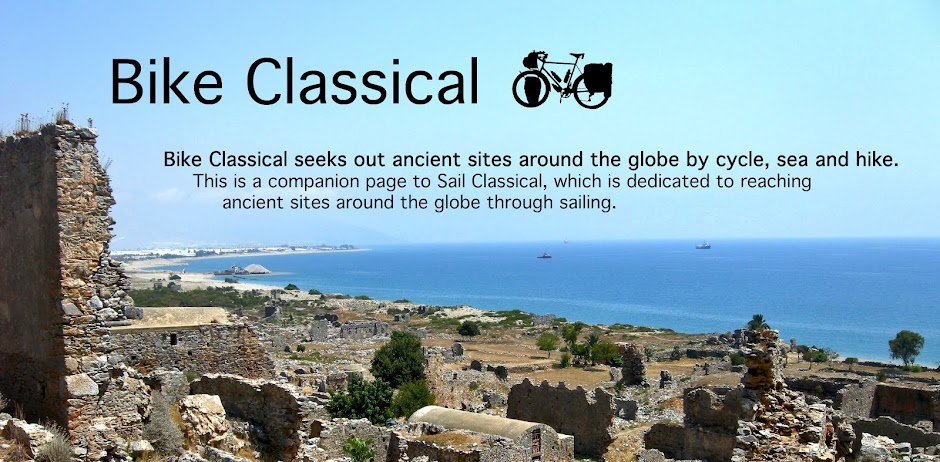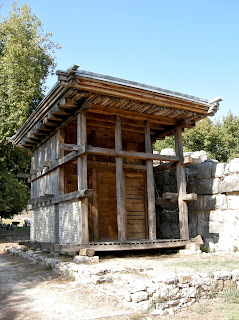Photos by Jack A. Waldron
Limyra, which is located approximately 5 kilometers northeast of Finike (ancient Phoenicus) on the Limyrus River, was one of the oldest and most prosperous cities in Lycia. Pictured above, my bicycle is leaning against the protective fence that encircles the ancient theater.
The beginnings of the ancient city have been found on the citadel, which sits about 320 meters above the theater on Mt. Tocak (1215 meters), and refers to the 5C BC settlement by its Lycian name, Zemuri. The 4C BC Lycian king Pericles, whose image appeared on coins minted in the city, had his finely decorated tomb built just below the citadel.
The Theater at Limyra dates from the Roman period, and displays the common semicircular design typical of Roman theaters of the time.
The building design is not so dissimilar to other Roman theaters from the period. The theaters from Side and Myra come to mind with their vaulted entrances and passageways.
The structure has a single diazoma, with 8 staircases separating 9 cunel, and probably seated about 12,500 spectators.
The analemma has a back wall 1.6 meters in height with 8 arched entrances giving access to the vaulted passageway, which intern leads to vaulted entrances/exits on either side of the building (pictured below).
Pictured above, a section of the Byzantine wall seen from the inside not far from the Gaius Caesar Cenotaph (pictured below).
Gaius Caesar was the grandson (adopted) of the Emperor Augustus, and was to succeed as emperor to Rome following the death of Augustus.
On February 21st, 4 AD, Gaius Caesar died in Limyra as the result of a serious wound he had received during a battle in Armenia. Upon Augustus's request, the body was sent back to Rome and buried in the Mausoleum of Augustus.
In dedication to Gaius Caesar, the Limyrians built the ornately decorated monument known as the Gaius Caesar Cenotaph (pictured above).
It is impossible to gain a real appreciation for the size and beauty of the monumental structure as it appears today, as the lower step alone stands at a height of almost 5 meters.
Further, sections of the frieze on display at the Antalya Archaeological Museum attest to the grandeur of the decoration (pictured above).
Today, only the base and the solid structure of the monument's inner core remain. Moreover, gushing spring fed river waters have drowned the monument to the point that less than a meter of the base wall is visible.
There's quite a contrast between the early period excavations of the Gaius Caesar Cenotaph site, with its dry parched landscape (pictured above), and the same area made lush and green from the opportune spring waters of the Limyrus (pictured below).
Pictured below, yet a another illustration of the Gaius Caesar Cenotaph, and a testament to the historical importance of the man who would be emperor of one of the most powerful and most influential empires in the history of mankind.
From the Gaius Caesar Cenotaph, I proceeded east to the Hellenistic Tholos believed to be a monument dedicated to the cult of Ptolemy for assistance in the defense of the city against Celtic invaders from Galatia in the north (pictured above, and illustrated below).
Two statue fragment excavated at the site are believed to be representations of Ptolemy II Philadelphus 285-246 BC. Also identified are Celtic shields that appear on the balustrade between the columns, which suggest a monument dedicated to the cult Ptolemy.
The circular cella was built atop a Lycian Hellenistic era podium that is 15 meters square, and once stood 10 meters high (pictured above). Also pictured above, one can see a protective wall that runs through the center of the monument, which was probably constructed under Byzantine rule.
The magnificent lion sculptures found at the site (pictured above and below), are now on display at the Antalya Archaeological Museum. These lions were placed at the corners of the podium to guard the temple.
The fluted Ionic columns (pictured above) supported and architrave of fine detail under a metope-tryglyph frieze, which depicts the victory of Lapiths over the Centaurs (pictured below).
Further, over the door and windows of the peripheral, there is evidence of a frieze depicting a chariot race.
Crowning the Cult of Ptolemy Tholos was a monumental Corinthian acroterium with snake scales between acanthus leaves offering further protective motifs, and a third architectural style (pictured below).
Pictured below, the Corinthian acroterium of the Cult of Ptolemy Tholos on site with the remaining structure in the far left background.
Today, the area on the east side of the the Cult of Ptolemy Tholos is inundated with the crystal clear spring water of the Limyus (pictured above), which now flows down the the colonnaded street that once connected the city to the ancient harbor at Phoenicus (pictured below).
Columns from the colonnaded street and various other fragments scattered around the site can be discovered (pictured below).
Pictured above, what is believed to be an ancient pedestal for a victorious ship, or perhaps the chariot of warrior to commemorate their victory in battle.
Next to the pedestal are fragments of a sculpture depicting a charioteer driving his horses into battle. Whether this was a monument at all, or whether it glorified a victory or defeat, we will probably never know.
Approximately 220 meters above the theater in the middle of the south wall of the citadel are the remains of the Monumental Tomb of Pericles, who reigned over the 4C BC Lycian City during one of its most prosperous periods.
The Heroon, erected by Pericles sometime between 370-350 BC, was built atop a burial chamber upon which a front and rear porch of Cariatids supported the upper structure that took the form of an Ionic temple. The appearence and similarities of this monument with the Erechtheion on the acropolis in Athens, which sits above the burial chamber of the Attic King Kekrops, is striking.
Pictured below, fragments from the Tomb of Pericles are display at the Archaeological Museum of Antalya. In the left of the picture, one of the remaining Cariatids stands tall upon its base.
Pictured above and below, the central acroterium sculpture of the north facade is the beheading of Medusa by Perseus, while acroteria at the corners depict the fleeing sisters of Medusa.
Pictured above, the central acroterium sculpture of the north facade is the beheading of Medusa by Perseus, while acroteria at the corners depict the fleeing sisters of Medusa (pictured below).
The appearence and similarities of this monument with the Erechtheion on the acropolis in Athens, which sits above the burial chamber of the Attic King Kekrops, both of which feature exquisitely sculpted Cariatid columns, is striking.
Pictured above and below, the Cariatid columns of the Tomb of Pericles at Limyra on display at the Archaeological Museum of Antalya.
The two 6 meter long friezes that adorned the side walls of the cella depict a military themed procession that is marching south down the slope toward the city center, and is thought to show the loyalty of Pericles to Persia.
Pictured below, on the site of Limyra there is a Lycian house that has been constructed based on Lycian rock-cut house tombs that can be found throughout Lycia.
*All photos and content property of Jack A. Waldron (photos may not be used without written permission)
**If you'd like to help with future postings, please feel free to support them through PATREON:






















































No comments:
Post a Comment
Note: Only a member of this blog may post a comment.